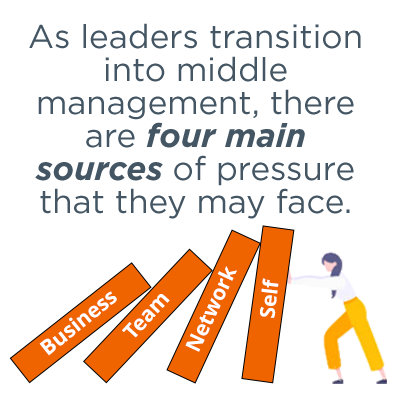In organizations, middle managers are like bridges. Just as bridges provide passage across physical obstacles like a body of water, valley, or railway, middle managers connect different teams across strategic levels of companies. Without the bridge, it would be very difficult to move efficiently or easily from one place to another.
And like bridges, middle managers require care and improvement to ensure these connections happen effectively. Middle managers need regular development experiences or "maintenance" to be their best. Your middle managers bridge the gap between strategy-driven executive leaders on one side and execution-driven frontline leaders on the other. Failing to invest in and develop the capabilities of your middle managers can be a risky—and costly—mistake.
Why Middle Manager Development Is Important
The term “middle manager” covers the large group of job titles that fall between frontline and executive leaders. They manage many different functional groups and have complex and varied development needs. They also face unique leadership challenges when transitioning into the role. Many organizations allocate leadership development budgets for frontline or executive leaders, leaving middle managers to “grow into the role” or figure it out on their own. But the transition into middle management is no less challenging than the transition into other levels of management. More than one-third of leaders across levels described their transition from one leadership level to another as overwhelming or very stressful. At least 5% of leaders thought of quitting.
In our Global Leadership Forecast, only 26% of HR professionals rated their mid-level leader quality as very good or excellent. It’s no coincidence that only 27% of HR professionals rated their mid-level program quality as high or very high. This is a costly mistake, considering that mid-level leaders are both the developers of future talent and future executives in your organization.
In a podcast episode, McKinsey highlighted the important role that middle managers play in attracting, developing, and retaining talent. As we’ve come to understand in 2022, quiet quitting is the latest signal of low employee engagement and can be the beginning of loss of talent. Middle managers are vital in communicating the purpose of the company and value of teams, offering development opportunities, and setting the tone for a respectful culture.
In addition to their responsibilities to cultivate leaders of frontline teams, middle managers also represent an organization’s bench of future executives. According to DDI's Leadership Transitions Report, the success rate for executives hired internally is 25% higher than external hires. Organizations that offer resources for middle manager development build leaders that are ready to move into executive roles. Plus, this investment gives them the development that they crave to stay engaged and effective in their current role.
Leadership Skills That Managers in the Middle Need to Advance

You’ve probably heard the saying “What got you here won’t get you there.” Oftentimes, middle managers were successful individual contributors and frontline leaders. That’s why they got promoted! But they may struggle with the transition into middle management.
Unlike most frontline leadership, mid-level leadership is multidirectional. Leaders find themselves stretched in all directions, navigating expectations from across multiple stakeholders and various teams. They must now deal with practical challenges like decision making or P&L complexity or personal challenges, like a lack of confidence among a new, more experienced peer group or managing increased stress. As leaders transition into middle management, there are four main sources of pressure that they may face. Their ability to navigate these pressures often determines whether they succeed or fail as they move up the ladder.
1. Leading the Business
Middle managers must translate their company’s strategy into execution. This requires complex decision making and comes with risk. They must shift from the tactical focus of frontline leadership to the broader focus of strategic leadership. If they can’t shift their mindset to a long-term vision, they may revert to frontline behaviors, focusing on operational tasks and unintentionally neglecting long-term organizational goals.
2. Leading Teams
Middle managers are the ambassadors of organizational culture. And with the shift to remote and hybrid work, middle managers may be the only faces of company senior leadership that employees regularly see. In the absence of traditional “brick and mortar” office culture, the leader is the culture. They may also lead global, diverse teams, requiring more developed communication and interpersonal skills to convey clear and compelling visions across teams, provide purpose, and clarify the organization’s strategic priorities.
3. Leading Networks
With a larger network of constituents, skills such as influencing and stakeholder management become essential. It’s easier to get things done when driving execution at the front line with a team. But success in the middle requires working across boundaries to influence colleagues they may not have direct reporting authority over. To make progress, middle managers must navigate competing priorities, organizational politics, and limited resources across different groups in the organization. They must make sure that key stakeholders are aligned and involved in executing the strategy.
4. Leading Self
Leaders are more visible now, and such change comes with the role. As a mid-level leader, you are managing larger, more strategic initiatives, making decisions with larger consequences, and influencing across your network and organization. As a result, success and failure is more visible to your teams, peers, and senior leadership. This means that their leadership style, tendencies, and behaviors are also more visible. Greater risk, greater consequences of failure, and greater uncertainty require middle managers to gain self-awareness of personality traits that could derail success or erode trust and learn how to effectively manage them. Interpersonal skills also become critical as middle managers rely on other teams and leaders to achieve goals.
Strategies to Engage Middle Managers
To engage your middle managers, you must first recognize that they have unique learning needs.

1. Deeper business and leadership development experience
Middle managers want to dive into business strategy, not just theory. And they seek guidance from experienced senior leaders.

2. Greater psychological safety
While psychological safety is important at every level, as leaders get higher in the organization, self-disclosure becomes riskier. They may be reluctant to admit that they’re struggling, fearing that they will look weak or unfit for their role. At this level, it is more critical than ever that they feel psychologically safe and have protected learning environments.

3. Focus on self-awareness and mindset
At this level, a leader’s personal impact cascades across many people, and new mid-level leaders may not realize how their habits and tendencies begin to deeply affect others and their ability to engage others. Self-awareness is crucial. Self-insight tools and personal reflection are key to development at this level.

4. More complexity
Middle managers benefit from challenging learning experiences, including complex experiential exercises. Simple models must be adapted to reflect the complexity of the role.

5. Facilitator credibility in judgment
As leaders move into higher-level roles, they need higher-level facilitators with greater business experience to increase relevancy and advance conversation. Instead of one-way communication where knowledge is transferred, facilitators must engage leaders by leading discussion, seeking examples, and offering analogies.

6. Expect to network and learn with peers
Mid-level leaders are increasingly busy and geographically dispersed, making it difficult to connect with peers. But as they play a broader role in working across silos to get things done, networking with their peers should be a critical part of their development experience. Learning experiences must promote opportunities to learn from one another. Sometimes a leader just needs to hear that they aren’t alone and that others have the same challenges.
The Principles of Leader-First Instructional Design
Once you understand the unique learning needs of middle managers, it’s helpful to consider the design principles that can create deeply engaging learning experiences.

1. Relevant
“Connect with my challenges and organization.” Without an explicit connection to their everyday work, training can seem like a distraction. Learners should be able to immediately apply new skills and concepts. Real-world challenges, case studies, and on-the-job application are a must.

2. Personalized
“Highlight what the unique value is for me.” Learning content and learning modality must be personalized, ideally with learners choosing the approach and content they prefer. Leaders need to understand which skills to focus on and how development in these areas can improve their career satisfaction. Insight tools and self-assessments can ensure that leaders see a personal connection to the content.

3. Immersive
“Let me experience the challenge.” Leaders learn by doing, practicing, and experiencing leadership challenges in a realistic environment. Problem solving and peer discussions about real challenges make development feel more like a working session and less like training.

4. Human
“Help me feel the emotional connection to the situation.” Leadership is intensely human, so examples and case studies must be rooted in reality. Development approaches can highlight the human experiences of mid-level leadership by addressing and acknowledging the complexities and multidirectional pressure leaders face. Reflection and insights help leaders see the emotional connection and consequences of their actions.

5. Trusted
“I’m going to get value out of this.” Don’t waste a leader's time. With Google at our fingertips, we can all get an answer to any question in seconds, even if it's incorrect. Content must be research-based and backed by science so it will deliver measurable behavior change.
Middle Management Training Programs
Fortunately, there are middle manager development programs that address the challenges unique to this role. The most effective programs address the skills that middle managers struggle with most and are informed by data from assessments and coaching engagements at this level.
As a signature feature of these programs, leaders can simultaneously learn and strengthen their professional networks. This cohort-based development model enhances outcomes and offers a more scalable approach than one-on-one coaching to develop middle managers with varying levels of experience. As leaders learn from each other through practice and feedback, cohort-based sessions are highly focused on key leadership skills and leaders cultivate new strategies and tools they can apply immediately.
Don’t Put Off Investing in Your Middle Managers
It’s clear to see that middle management training has important value as a critical part of your company’s leadership development program. Success at the top of the org chart comes from appropriate development at all levels below. Many organizations are doing little to prepare middle managers for success, but you can help your company get ahead by providing impactful training to help them thrive. Developing your middle managers will drive business execution, increase retention and engagement, and build your bench of future executives.
Stop taking middle managers for granted before it’s too late and invest in their development. Remember, they are the bridge between where your organization is today and where it has the potential to be tomorrow.
Learn more about DDI’s middle manager training and leadership development solutions.
Lisa Rectenwald is a product manager at DDI, based in her hometown of Pittsburgh, PA. When she’s not creating new learning experiences for middle managers, Lisa can be found relaxing on the beach, staring at the stars, singing along to a Broadway musical, or travelling to a new city to see a Phish concert!
Topics covered in this blog

